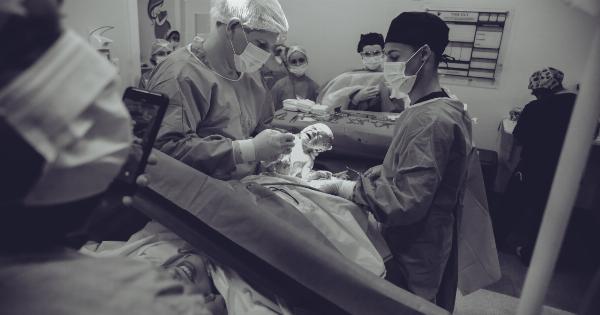A Caesarean section (C-section) birth is a surgical procedure in which the baby is delivered through an incision in the mother’s abdomen and uterus.
While vaginal birth is considered the most natural way to give birth, there are situations where a C-section may be the preferred or necessary method of delivery. Although C-sections are often associated with higher risks and longer recovery times, they also offer several benefits for both the mother and the baby.
Reduced Risk of Birth Trauma
One of the significant benefits of a C-section is the reduced risk of birth trauma for both the mother and the baby.
In some cases, particularly when the baby is large or in an abnormal position, attempting a vaginal delivery can lead to complications such as shoulder dystocia. This condition occurs when the baby’s shoulders get stuck behind the mother’s pelvic bones, potentially causing nerve damage or fractures. By delivering the baby via C-section, the risk of birth trauma is significantly minimized.
Planning for High-Risk Pregnancies
C-sections play a crucial role in managing high-risk pregnancies. Some medical conditions, such as preeclampsia, placenta previa, or certain infections, can pose a significant threat to the mother and the baby during vaginal delivery.
By opting for a C-section, healthcare providers can carefully plan the delivery, ensuring the safest outcome for both the mother and the baby.
Emergency Situations
In certain situations, a C-section may be the only option to save the life of the mother or the baby.
When complications arise during labor, such as umbilical cord prolapse or placental abruption, an emergency C-section can be performed swiftly to avoid potentially fatal outcomes. The ability to quickly deliver the baby through a surgical procedure can be life-saving in critical situations.
Controlled Delivery Timing
Another advantage of a C-section birth is that it allows for greater control over the timing of delivery. In some cases, a scheduled C-section can be beneficial, such as when the baby needs to be delivered before full term due to medical reasons.
This can help ensure that specialized neonatal care is available immediately after birth for any necessary interventions. Additionally, scheduling a C-section can be convenient for families who need to plan for child care or have other logistical considerations.
Reduced Risk of Pelvic Floor Disorders
Pregnancy and vaginal delivery can put significant stress on the pelvic floor muscles, leading to long-term complications such as urinary incontinence or pelvic organ prolapse.
By opting for a C-section, women can avoid the potential damage to their pelvic floor, reducing the risk of such disorders later in life. This can have a positive impact on the woman’s quality of life and avoid the need for future corrective surgeries.
Lower Risk of Infant Infections and Injuries
C-sections are associated with a lower risk of certain infant infections and injuries. During a vaginal delivery, the baby may be exposed to bacteria from the birth canal, which can lead to conditions such as respiratory infections or neonatal sepsis.
The risk of these complications is significantly reduced when the baby is delivered via C-section. Additionally, the chances of birth asphyxia or other birth injuries are minimized, as the controlled surgical procedure ensures a safe and gentle delivery.
Safer for Women with Previous C-sections
For women who have previously undergone a C-section, opting for a repeat C-section is often the safest choice.
Attempting a vaginal birth after cesarean (VBAC) carries certain risks, such as uterine rupture, which can be life-threatening for both the mother and the baby. Choosing a planned C-section eliminates this risk and provides a safer delivery option for women with a history of C-sections.
Immediate Access to Medical Care
Another advantage of a C-section birth is that it provides immediate access to specialized medical care for both the mother and the baby.
In case of any complications or emergencies during or after the procedure, healthcare professionals are readily available to respond and provide the necessary interventions. This ensures that potential problems can be quickly addressed, minimizing the risk of adverse outcomes.
Less Stressful for Some Mothers
For some women, the idea of a vaginal delivery can be anxiety-inducing or stressful. Choosing a C-section can offer a sense of control and provide emotional comfort for those who may fear the pain or unpredictability associated with natural birth.
It’s essential for women to feel empowered and supported in their childbirth choices, and a C-section can be a preferred option for their overall well-being.
Reduced Risk of Incontinence
Urinary incontinence is a common concern among women, especially after childbirth. Vaginal delivery can increase the risk of developing incontinence due to nerve and muscle damage.
By delivering via C-section, women can bypass the potential trauma to the pelvic floor muscles and nerves, leading to a lower risk of urinary incontinence. This can significantly improve their postpartum experience and overall quality of life.
In Conclusion
While vaginal birth remains the preferred method for many women, a C-section birth offers several benefits in certain situations.
From reducing the risk of birth trauma and improving outcomes in high-risk pregnancies to providing immediate access to medical care, the advantages of a C-section are undeniable. It’s crucial for expectant mothers to discuss their options and make an informed decision with their healthcare providers to ensure the safest and most suitable delivery for both themselves and their babies.




























